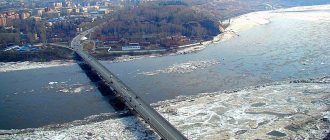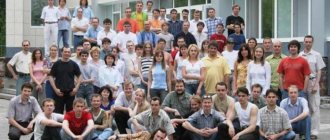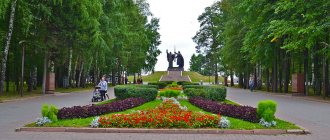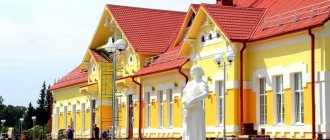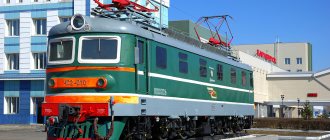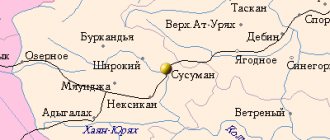Tomsk region
| Coat of arms of the Tomsk region | ||
| Flag of Tomsk region | Coat of arms of the Tomsk region | |
— Total — % aq. turn 16
314,391 km² 0.4Population
— Total — Density 51st
approx. 1,045,541 (2010) approx. 3.33/km² Federal DistrictSiberianEconomic regionWest SiberianGovernorSergey ZhvachkinChairman of the Regional DumaOksana KozlovskayaVehicle code70TimezoneMSK+3 (UTC+6, summer UTC+7)
Tomsk region
- a subject of the Russian Federation, located in the southeast of the West Siberian Plain, in the southwestern part of the Siberian Federal District. The administrative center of the region is the city of Tomsk.
History[edit | edit code]
The development of the region's territory began at the end of the 16th - beginning of the 17th centuries. The oldest settlement in the region is the village (formerly city) Narym, founded in 1596. The administrative center of the region, Tomsk, was founded in 1604. In 1804, the Tomsk province was formed, which existed until 1925, when it became part of the Siberian region. The Tomsk region was formed on August 13, 1944 by separating part of the districts and the former Narym district from the Novosibirsk region.
Population[edit | edit code]
Population 1045.5 thousand people (2010)[1], 51st in terms of population among the constituent entities of the Russian Federation (0.7% of the Russian population), of which 70.2% are urban (2009), population density: 3.3 people/km² (2009)[2].
Before the annexation of the region's territory to Russia in the 17th century, the main population was Siberian Tatars, Selkups and Khanty. According to the results of the 2002 All-Russian Population Census, Russians make up about 91% of the total population (about 951 thousand people). Of the other peoples, the largest share (from 2.0 to 0.1%) of the population is made by Tatars, Ukrainians, Germans, Chuvashs, Belarusians, Bashkirs and Jews.
Geography[edit | edit code]
The area of the region is 316.9 thousand km², the 16th largest among the constituent entities of the Russian Federation, which is 1.9% of the total territory of Russia. The length from north to south is about 600 km, from west to east – 780 km. Thus, the Tomsk region is approximately 1.5% larger in area than Poland (and almost 40 times smaller than Poland in population). The Tomsk region borders in the north with the Tyumen region and the Khanty-Mansi Autonomous Okrug, in the south with the Kemerovo and Novosibirsk regions, in the west with the Omsk region, and in the east with the Krasnoyarsk Territory[2].
Most of the region's territory is inaccessible, as it consists of taiga (forests occupy 63% of the area) and swamps (28.9%, in particular the largest Vasyugan swamp in the world). The highest point of the region is 274 m above sea level, the lowest is 34 m above sea level. The largest lake is Mirnoe (Parabelsky district), the surface area is 18.3 km². The region borders on the Krasnoyarsk Territory, Tyumen, Omsk, Novosibirsk and Kemerovo regions. The climate is continental. The main river, the Ob, crosses the region diagonally from southeast to northwest, dividing the region into two almost equal parts.
Time zone[edit | edit code]
The Tomsk region is located in the time zone designated by international standard as Omsk Time Zone (OMST/OMSST). The UTC offset is +6:00 (OMST, winter time) / +7:00 (OMSST, summer time) due to daylight saving time in that time zone. Relative to Moscow time, the time zone has a constant offset of +3 hours and is designated in Russia accordingly as MSK+3. Omsk time differs from standard time by one hour, since maternity time is in effect in Russia.
Who will be the new mayor of Tomsk
At the beginning of the working week, lawyers for the mayor of Tomsk Ivan Klein appealed the mayor’s sentence - on the eve of the New Year holidays, he was sentenced to two years in prison. The politician was found guilty of abuse of power and illegal entrepreneurship. At the same time, Tomsk is one of the few cities in the country where there are still direct elections for the mayor, and Klein, who was under investigation, was never removed from office. What can now change in the management system of the regional capital and who is vying for the post of mayor - in the FederalPress material.
Worked his way up to prison
Tomsk's control system has been in limbo for more than a year. Mayor Ivan Klein was detained on the morning of November 13, 2022 during a conference call with the administration. During the trial, the politician underwent a complex operation at the Oncology Research Institute and was released from pre-trial detention center under house arrest. After lengthy discussions, the court even granted the accused relief, allowing him to meet with relatives according to a certain schedule. On the eve of the New Year holidays, it was actively discussed on the political sidelines that the end of the trial was close. And indeed, on December 30, the sentence was announced: two years in prison, to be served in a general regime colony, as well as a fine of 200 thousand rubles. In addition, after his release, the official was banned from working in the civil service and local government for three years.
More on the topic
Defenders of the Tomsk mayor challenged the verdict
The politician's defenders have already filed an appeal and intend to defend the mayor's innocence. Today, the duties of the head of Tomsk, instead of Ivan Klein, are performed by his first deputy Mikhail Ratner , but the formal resignation of the mayor has not happened during all this time. However, according to FederalPress experts, regardless of the decision of the appellate court, Klein is unlikely to have a desire to return to the political arena after his release. Political strategist Igor Kozlov believes that the mayor has already been erased from the public sphere.
“Now the question is different - who will compete with Mikhail Ratner? I would like to recall the famous phrase from Gaidai’s film: “Please announce the entire list,” noted the political strategist.
A holy place is never empty
Tomsk Mayor Ivan Klein has long been considered one of the most stable and wealthy mayors in the Siberian Federal District. People's love was confirmed by flash mobs organized by city residents. For example, on his birthday, a collection of signatures was organized at the courthouse demanding a change in the preventive measure. However, this is unlikely to help Klein remain as mayor.
More on the topic
Tomsk Mayor Ivan Klein was sent to a colony
“Ivan Klein will definitely be dismissed. A criminal cannot hold public office, even if he were given a suspended sentence,” political scientist and general director of the Institute of Regional Problems Dmitry Zhuravlev told FederalPress.
As soon as the position of mayor officially becomes vacant, a new mayor will be quickly found, the expert is sure.
“The main thing is that the next boss doesn’t go to jail. And this is not a joke. People feel bad because a person, having become the leader, sees nothing further than his own values,” Zhuravlev emphasized.
Political scientist Ilya Grashchenkov also believes that the resignation of the mayor is not far off and it is possible that the election of the governor of the Tomsk region, scheduled for September 11, 2022, will coincide with the election of the head of the city.
“The gubernatorial campaign in Tomsk is already assessed as one of the most difficult in Russia, and if it is associated with the mayoral election, this will force the authorities to negotiate. It’s difficult to name names now, but I think that this will be a compromise figure who will be able to solve the problems that have accumulated in the city,” the expert is sure.
Let us note that Ivan Klein was elected mayor in 2013; before that, he headed Tomskoe Beer OJSC for over twenty years. After he went to work at the mayor's office, the company was headed by his wife Lyudmila Klein.
Tomsk is on the verge of voting
More on the topic
In Tomsk they demand to maintain direct elections of the mayor
Tomsk remains one of the few cities in Russia that still holds direct mayoral elections. Last summer, deputies of the region's Legislative Duma rejected a bill proposing to abolish such an expression of will. Moreover, the discussion was really loud at that time: City Duma deputy Ilya Leontyev spoke on his Instagram account about a picket campaign to collect signatures for maintaining direct elections of the head of the city.
“We must defend our rights! A smart city itself must choose who its mayor will be,” the deputy said then.
Similar sentiments persist today. City Duma deputy Artem Konarev is confident that no changes are expected and the head of the city will have to be chosen by citizens.
“Only one candidate has announced so far - the acting mayor of Tomsk Mikhail Ratner, we’ll see who else will be there. He is very dependent on his rivals, and with strong candidates, his loss is not excluded,” the deputy noted.
Chairman of the Municipal Economy Committee Alexander Gubar , who represents the interests of the Communist Party of the Russian Federation in the City Council, also stated that direct elections will definitely be held in Tomsk.
“Today, Mikhail Ratner has potential rivals. I won’t name names, but there are literate and thinking people who could go to the polls,” the deputy believes.
However, not all observers are confident in the participation of Mikhail Ratner. He has good political weight, but is inferior to his predecessor in charisma. Political scientist Igor Kozlov believes that the work of the current acting... O. will be assessed closer to the elections, and the outcome of the vote may also be influenced by the opinion of Ivan Klein - nothing prevents him from expressing his position in the role of an ordinary citizen.
“Whether he’s passable or not is for Tomsk residents to decide, but from the point of view of promotion from power, most likely, the bet will be placed on Mikhail Ratner. I think Ivan Klein’s position can play an important role in the elections,” summed up Igor Kozlov.
Photo: FederalPress / Evgeniy Potorochin, Polina Zinovieva, RIA Novosti / Stanislav Savelyev
Administrative-territorial division[edit | edit code]
4 urban districts, 16 municipal districts, 3 urban and 117 rural settlements, 576 rural settlements.
| Districts of the Tomsk region | |
| Alexandrovsky | Asinovsky | Bakcharsky | Verkhneketsky | Zyryansky | Kargasoksky | Kozhevnikovsky | Kolpashevsky | Krivosheinsky | Molchanovsky | Parabelsky | Pervomaisky | Teguldetskiy | Tomsk | Chainsky | Shegarsky | |
| Districts of the Tomsk region | |
| Alexandrovsky | Asinovsky | Bakcharsky | Verkhneketsky | Zyryansky | Kargasoksky | Kozhevnikovsky | Kolpashevsky | Krivosheinsky | Molchanovsky | Parabelsky | Pervomaisky | Teguldetskiy | Tomsk | Chainsky | Shegarsky | |
| Settlements with a population of more than 5 thousand as of January 1, 2005 | |||||||||||||||||||||||||||||||||||||||||||
| |||||||||||||||||||||||||||||||||||||||||||
Administrative structure
As you know, the area of the Tomsk region in sq. km exceeds 314 thousand. Of course, for easier administration, the entire territory is divided into several administrative units. Moreover, it is divided quite unevenly – we’ll talk about this a little later.
In total, the region consists of twenty urban districts and districts. The largest regional center in terms of population is the city of Tomsk. Almost 595 thousand people live here. According to this indicator, he is in first place. But in area it is much smaller than most other administrative units. Despite the impressive total area of the Tomsk region, the territory of the regional center is only 295 square kilometers.
The largest administrative unit in these parts by area is the Kargasok district. Its area is close to 87 thousand square kilometers. But the population is surprisingly small - less than 20 thousand people.
The Verkhneketsky district with an area of 43,349 square kilometers is almost twice as large as the leader. Very few people live here – less than 16 thousand people.
The smallest district is Kozhevnikovsky. Its area is only 3,908 square kilometers, but in terms of population it is not inferior to, or even surpasses, the largest districts of the region: more than 20 thousand people.
The Zyryansky district is only slightly ahead of it. Its area is slightly larger - 3966 square kilometers, but its population is almost half as much - 11 thousand people. And this is on a territory almost twice the size of such a prosperous state as Luxembourg, whose population is almost 600 thousand people.
As you can see, the population and areas of the districts of the Tomsk region are distributed very unevenly. This is influenced by the size of areas suitable for living, the availability of jobs and simply historical factors.
Rivers[edit | edit code]
In the Tomsk region there are 18.1 thousand rivers, streams and other watercourses, with a total length of about 95 thousand km, including 1620 rivers with a length of more than 10 km (the total length of these rivers is 57.2 thousand km). The main water artery is the Ob River. The length of the Ob within the region is 1065 km. The main tributaries of the Ob, flowing into it in the Tomsk region: Tom, Chulym, Chaya, Ket, Parabel, Vasyugan, Tym.[3] The duration of the navigation period is 170-180 days.
Natural resources[edit | edit code]
The Tomsk region is rich in natural resources such as oil (82 fields, 1449 million tons), natural gas (632 billion m³), ferrous and non-ferrous metals, brown coal - 74.7 billion tons (first place in terms of reserves in Russia), peat ( second place in terms of reserves in Russia) and groundwater. In the region there is the Bakcharskoye iron ore deposit, which is one of the largest in the world (57% of all iron ore in Russia), the total reserves are 90 billion tons. In the Tomsk region there are many deposits of raw materials for building materials: clay, sand, limestone, shale, gravel The Middle Ob region has mineralized groundwater at a depth of 1100-2250 m. In the area of the city of Tomsk there are outlets of radon water. In addition, there are proven reserves of kaolin, refractory clays, glass and ilmenite-zircon sands (ilmenite - 3.4 million tons, zircon - 1380 thousand tons), leucoxene and rutile (600 thousand tons), bauxite, brown coal, zinc , gold, platinum and titanium[4].
Forests are one of the most significant assets of the region: about 20% (more than 26.7 million hectares) of forest resources in Western Siberia are located in the Tomsk region. The region is home to 28 species of wild animals, more than 40 species of birds and 15 species of fish of commercial importance; pine nuts, mushrooms and berries are harvested[5]. In the Tomsk region there are 15 zoological reserves (Tomsky, Verkhne-Sorovsky, Ilovsky, Kaltaisky, Karegodsky, Ket-Kassky, Malo-Yuksinsky, Oktyabrsky, Osetrovo-nelmovy, Paninsky, Pershinsky, Poskoevsky, Tongulsky, Oglatsky, Chichka-Yulsky), 2 landscape (Larinsky and Pol-To) and 1 botanical (South Taiga)[6]. 145 natural monuments have been identified in the region, of which 69 are located in the Tomsk region, in particular, the Talovskie Bowls, Blue Cliff, Dyzvezdny Klyuch, Peschanoe Lake, etc.
Number and density of population
The total number of residents here, according to the 2022 census, is only 1 million 78 thousand people. Of course, given the huge area of the Tomsk region in hectares (about 26.7 million), this is surprisingly small - only 3.4 people per square kilometer.
Of course, the population is distributed extremely unevenly. In cities, the density increases significantly, for example, in Tomsk the density is 1947 people per square kilometer. In smaller settlements it is measured in hundreds of people. But around these tiny spots on the map lie thousands of square kilometers of swamps and forests, where people either do not visit at all or visit only temporarily, traveling from one city to another.
By the way, many people would be interested in what the residents of the city of Tomsk are called - the name formed according to standard templates sounds very unusual. In fact, their name is Tomsk.
The percentage of urbanization in the region is quite high. More than 72% of the population lives in cities. The highest density was recorded in settlements located along the banks of the Ob and its tributaries. This is not an accident at all - getting out of many populated areas in the spring thaw, as well as in the winter snowstorm, can be very difficult. But rivers do an excellent job of serving as roads, allowing you to travel almost all year round without fear of getting stuck in the mud.
Industry[edit | edit code]
According to the Russian Ministry of Economic Development, in 2004 the Tomsk region was classified as a region with an above-average level of development (18th place in the country). At the same time, the region ranked 14th in terms of the average monthly salary (9,640 rubles), the volume of paid services per capita (18.8 thousand rubles), and tax revenues to the budget per capita (60.4 thousand rubles). ). The main priorities of economic development are fuel and energy, scientific and educational complexes and small business.[7].
In 2004, industry contributed 45.5% of regional GDP, agriculture - 19% and construction - 13%. Of the industrial sectors, the most developed in the region are fuel (52.8%), including oil production (48.5%) and mechanical engineering (12.6%). chemical and petrochemical industry. The large share of non-ferrous metallurgy (8.9% in 2004, 20.3% in 2001) is explained by the fact that the products of the Siberian Chemical Plant traditionally belong to this industry[8]. Main exported products: oil (62.1%), methanol (30.2%), machinery and equipment (4.8%). Joint ventures in the region are primarily involved in oil production and logging. The main branches of agriculture are meat and dairy farming, animal husbandry and crop farming.
History of the Tomsk region
More details
: Tomsk history
First mention of the concept Tomsk region
associated with the administrative reform of the Siberian territories carried out by Empress Catherine II in 1764-1782[4].
It was decided to abolish the Kingdom of Siberia, created in 1764 as part of the Russian Empire, creating (as in other regions of the country) instead 4 governorships
(the prototype of future
provinces
): Tobolsk, Perm, Kolyvan and Irkutsk.
In the process of the abolition of the Siberian Kingdom
in 1775-1780, it was decided to divide
the Tobolsk governorship
[5] into two
regions
within it -
Tobolsk
and
Tomsk
[6][7], which were finally formed in 1782.
During the next reform, in 1796, both regions were merged into a single Tobolsk province
, from which on February 26, 1804 it was again separated into an independent and influential (central) Siberian province -
Tomsk province
[4]. The Tomsk province existed until May 25, 1925, and was transformed first into the Siberian Territory (1925-1930), then into the West Siberian Territory (1930-1937), and into the Novosibirsk Region (1937-1944).
After a series of administrative-territorial reforms of the early Soviet government (1925-1940s), in August 1944 the territorial-administrative unit of the country was re-formed (now a federal subject
) -
Tomsk region
. This process in the summer and autumn of 1944 was not easy.
Second time (after 1782) Tomsk region
was recreated, in the approximate, slightly trimmed boundaries of the former Tomsk and Narym districts of the former Tomsk province in the summer of 1944. The process began with the decision of the Organizing Bureau of the Central Committee of the All-Union Communist Party of Bolsheviks dated July 26, 1944 “On the formation of the Tomsk region as part of the RSFSR.” Then there was a Resolution of the Central Committee of the All-Union Communist Party of Bolsheviks, by which the new Tomsk region was withdrawn from the territories of the Novosibirsk region; The decree of the main governing body of the country determined the administrative (regional) center - the city of Tomsk, and also described the areas that were to enter the region or be liquidated. On August 13, 1944, in accordance with the decisions of the Central Committee of the All-Union Communist Party of Bolsheviks, the Decree of the Presidium of the Supreme Soviet of the USSR was signed on the creation of a new Tomsk region in the RSFSR[8].
However, the administrative party bodies of the Novosibirsk region were very dissatisfied with this formulation of the question ( Source of the statement?
) and repeatedly tried to influence the highest governing bodies of the USSR with requests to cancel or suspend these decisions. (
Source of approval?
) Only on August 22, the Novosibirsk Regional Committee of the All-Union Communist Party (Bolsheviks) for the first time considered the issue of forming the Tomsk region by separating part of the territories from the Novosibirsk region. On August 25, Tomsk residents first officially learned about the creation of the region - only on this day the newspaper “Red Banner” of the Tomsk City Committee of the All-Union Communist Party of Bolsheviks published the text of the Decree of the Presidium of the Supreme Soviet of the USSR dated August 13, 1944[9]. In September, the formation of governing bodies of the new region took place: first, on September 2, the Tomsk regional committee of the All-Union Communist Party of Bolsheviks was created [10] [9], and then the regional committee formed the regional executive committee, the regional court, the regional military registration and enlistment office, the regional committee of the Komsomol and the regional trade union committee. At the same time, the capital forms the UNKVD (police) of the Tomsk region, the prosecutor's office of the Tomsk region and the UNKGB. The status of the main newspaper of the region, the organ of the regional committee and the regional executive committee, is assigned to the newspaper "Red Banner".
War 1941-1945 and post-war period
The Tomsk region was re-established in the 20th century during the war. After a period of disastrous stagnation of the territory and its center - the city of Tomsk in 1918-1940, when it suddenly became a second-rate provincial city-district center from the status of the capital of the entire Siberian region [11]. Under the conditions of occupation of the western regions of the USSR by German troops, many industrial enterprises, educational institutions (including higher military institutions), theaters, etc. were evacuated to Tomsk and Asino. The city and region began life as a new industrial and defense center of the country. The high scientific and educational potential has been preserved - the city university, higher education institutions and research institutes not only did not weaken[12], but began to actively develop in the post-war period. There has been a dramatic change in the economic and social infrastructure of the entire region and its center. Even in the conditions of re-evacuation of some universities, colleges, industrial enterprises and research institutes, the Tomsk region continued to increase its economic potential.
Heyday 1964-1984
The flourishing (rapid development - in comparison with other regions of the USSR) of the region in economic (including agro-industrial production) and socio-cultural terms occurred in the period from the second half of the 1960s to the early 1980s. To achieve this, there was a successful combination of objective and subjective factors. Objective factors of economic development: exploration and start of industrial production in the Tomsk region of oil and gas (including the creation of hydrocarbon processing enterprises - one of the largest in the world, the Tomsk Petrochemical Plant, as well as the installation here of the UMNTS - Central Siberia Main Pipeline Management) systems. , construction of oil towns Strezhevoy and Kedrovy; launch of the Tomsk enterprise of the country's nuclear project
— Siberian Chemical Combine and the new city attached to it;
deployment of high-tech military-industrial complex enterprises in Tomsk for the production of military electronics; development of transport communications (river port, airport, fleet electronic warfare, railway stations and new stations, bus station, new roads and bridges). Subjective factors: high ambitions[13] and organizational abilities of the first secretary of the OK CPSU E.K. Ligacheva. Having the motivation to become the best of the Soviet regional leaders, he fully realized his managerial talent and the experience he gained as a manager during the creation of the Novosibirsk Academic Town (1950s). In Tomsk, thanks to this (voluntarism?) modern cultural objects, cinemas, libraries, and the DPP meeting house appeared; powerful territorial organizations of artists, poets, writers, theater workers, etc. were created. In addition to the objective factors [14] of the accelerated development of the region, E. Ligachev took measures to accelerate the development of the base of construction industry enterprises and the development of Glavtomskstroy, to the development of public transport (the appearance of a trolleybus , new modern trams in the 1980s, new fleets of city and intercity buses, a taxi fleet, etc.), to an advanced solution to the food problem for the population: deployment of a network of poultry farms around the regional center, pork production, organization of year-round supply of vegetables and fruits to citizens from greenhouse complexes (Tomsk, Kulagina street and near the village of Kuzovlevo). The region became exemplary
in a number of positions; secretaries of the CPSU Central Committee (the de facto leadership of the country) came here to study the work of the Tomsk House-Building Plant and the Tomsk MZhK created with its participation, the organization of the work of the Pig Farm with a capacity of 108 thousand heads of pigs per year and other achievements.
In 1967, the region was awarded the Order of the October Revolution[15].
Perestroika and post-perestroika
Perestroika in the Tomsk region began with painful remnants of the legacy of the era of outgoing socialism: Andropov’s war (1982-1984) against drunkenness and alcoholism resulted in the destruction of a number of food enterprises, in particular in the dramatic destruction of unique beer brewing vats at the Tomsk Beer Plant (1984)[17]. Liberalization of the political regime led to a change in the economic structure: since 1987, centers for scientific and technical creativity of youth (NTTM, the prototype of future student business incubators)
), the first cooperatives [18].
However, the general financial crisis of the country in 1988-1990, predetermined by the entire era of stagnation in the USSR, had an extremely detrimental effect on industry and social development. Military orders from the state and enterprises in the defense sector, the military-industrial complex, were curtailed, they began to get rid of their workers en masse, many of them closed. The requirement of the country's central authorities for self-sufficiency and self-sufficiency undermined the ability of agricultural enterprises to operate: collective farms stopped working and social tension arose in the countryside. Former leaders of industrial enterprises and party authorities in the region in the period 1991-1994 were actively involved in the redistribution of property. Without summing up and without analyzing the reasons for the collapse of the Soviet country and the collapse of its communist ideology, the Tomsk region, together with the entire country, entered the era of wild capitalism
. The result was the closure of many unprofitable industries (including in the military-industrial complex), but new commercial and manufacturing companies that were highly profitable and attractive for employment appeared. These include, in the post-perestroika period, TomskNeft (headed by L. Filimonov) and YUKOS, which replaced it, Tomsk Aviation Enterprise (1992-1999), most food industry enterprises, new enterprises in the field of telecommunications and information technology, and in the media industry. The question of the ability to effectively manage enterprises in real market conditions has become tough.
Modernity
The current position of the region is characterized as stable, while in 1999-2002, at public hearings and expert commissions, the main strategic guidelines for the possible progressive, sustainable development of the region were developed. In particular, the Tomsk region, in 2001, for the first time in the country, adopted its own program for innovative development of the region. Specially trained (in the leading cities of Russia, as well as in Western Europe) experts prepared directions for the development of the regional element base, and by 2007 almost all of them began to operate: centers for audit and commercialization of scientific and technical developments and inventions, centers for Russian and international technology transfer, business incubators of various specializations, etc. It was important to create in Tomsk, in one of the five cities of the country, a project for a classic technology park - the Tomsk special economic zone of technology-innovation type. This allows us to focus on the economy of knowledge, intelligence, innovation, to more fully realize the potential of universities and about a hundred research institutes and design and research centers, institutes, design bureaus and laboratories. The situation with industrial production and the oil and gas sector is characterized by the withdrawal of their capital from the taxable structure of the Tomsk region in 1995-2005. The same process is also characteristic of nuclear
sectors. After the decline of 1992-1996 in the economy of food and agricultural production, the situation in the countryside has somewhat stabilized[19].
Notes[edit | edit code]
- Population of districts and urban settlements of the constituent entities of the Russian Federation as of October 25, 2010
- ↑ a b Rosstat. Estimation of the permanent population of the constituent entities of the Russian Federation
- Study of the water quality of two rivers of the Tomsk region, Tom and Ushaika
- Tomsk region. Geological certificate, minerals
- Tomsk region on the tourist map of Russia
- Specially protected natural areas of the Tomsk region
- Report on the results of the implementation of the Program for the socio-economic development of the Tomsk region until 2005 (.doc)
- Social atlas of Russian regions / Tomsk region
- United Russia faction in the State Duma of the Tomsk region on the website of the regional branch of United Russia
Notes
- Population and ethnic composition of the Tomsk region
- Results of the 2002 census: ethnolinguistic situation in the Tomsk region
- Cultural heritage
- ↑ a b
Archives of Russia. Administrative-territorial division of the Tomsk province - Tomsk region (1604-1997). - In turn, the Tobolsk governorship became part of the single governorship general of Perm and Tobolsk. Perm and Tobolsk should be governed by one governor-general, “the ruler of the viceroyalty of Perm and the governor of Tobolsk” (Kashkin_Evgeniy_Petrovich). The abolition of the Siberian Kingdom and the transfer of power to the newly formed Tobolsk governorship took 2 years from 1780 to 1782. In 1780, the Perm governorship was formed, in 1782 - Tobolsk.
- The Tomsk region included the following counties: Achinsky, Kainsky, Yenisei, Narymsky, Tomsky, Turukhansky.
- Nek. sources report that in 1779-1782, due to the incompleteness of the reform of the Perm-Tobolsk governorship, the current problems of governing the Tomsk region were solved by the governor-general of the Kolyvan governorship, located closer to Tomsk - see Encyclopedia of the Tomsk Region, 2008
. - see documents of the CDNI TO: fund 4204, inventory 4, file 454, sheet 2 “Copy for the Tomsk region”. The original of the decree is stored in the State Archive of the Russian Federation: GA RF: fund R-7523, inventory 15, file 99, sheets of documents 1-3)
- ↑ a b
CNDI TO: To the 70th anniversary of the Tomsk region, stages of its creation - During the formation of the Tomsk Regional Committee of the All-Union Communist Party of Bolsheviks, its leader at first was also the head of the Tomsk City Committee of the All-Union Communist Party of Bolsheviks.
- After the Civil War, there was a massive outflow of intellectual and labor resources from Tomsk to other regions (primarily to Novosibirsk, the production and economic base was virtually absent. As a result, cultural and social decline, as well as the dubious “honor” of becoming one of the GULAG islands for accepting thousands and thousands of repressed people from all over the country were sent here to the taiga wastelands and to the Ob Islands.
- Evaluation against the background of conditions throughout the rest of the country. In the capital, it was believed that Tomsk in the post-war period was not at the high level of modern science and that a new domestic scientific center should be created “from scratch,” as Academician M.A. believed. Lavrentyev, they decided in an “open field near Novosibirsk”...
- After working in Tomsk E.K. Ligachev was introduced to the leadership of the USSR in 1982-1991.
- that is, the external requirements of the capital center
- Orders of the Soviet past
- The beginning of the Andropov campaign against alcoholism of the CPSU Central Committee occurred during the initial period of Comrade Comrade coming to the post of General Secretary of the CPSU Central Committee. M.S. Gorbachev. Who soon himself stopped this obvious bacchanalia of trying to fill the country’s concentration camps with able-bodied men for a low-cost and “effective” increase in the country’s GDP.
- However, the plant was lucky: by the second half of the 1990s, the new manager, Ivan Klein, managed to make the enterprise modern, profitable and one of the regional leaders in product quality.
- Among the first cooperatives in the field of electronics, then, in 1989, on the basis of MZhK DSK, the Elecard cooperative appeared, one of the current leaders in the production of unique software and hardware systems.
- With a clear process of young people leaving for the cities and stagnation in cultural and social terms.
